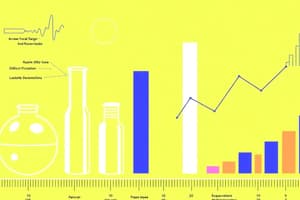Podcast
Questions and Answers
What is the primary purpose of randomization in an experiment?
What is the primary purpose of randomization in an experiment?
- To maximize the number of replicates
- To identify the dependent variable
- To minimize the effect of nuisance variables (correct)
- To determine the level of hardwood concentration
In the experiment on tensile strength, what is the independent variable?
In the experiment on tensile strength, what is the independent variable?
- Pilot plant production time
- Testing machine warm-up time
- Hardwood concentration (correct)
- Tensile strength
What is the primary benefit of using box plots to visualize the data?
What is the primary benefit of using box plots to visualize the data?
- To identify the exact value of the mean
- To determine the effect of the warm-up effect
- To compare the variability between treatments (correct)
- To show the correlation between variables
What is the purpose of replicates in an experiment?
What is the purpose of replicates in an experiment?
What is the primary advantage of using a completely randomized single-factor experiment?
What is the primary advantage of using a completely randomized single-factor experiment?
What is the consequence of not randomizing the order of the 24 runs in the experiment?
What is the consequence of not randomizing the order of the 24 runs in the experiment?
What is the range of hardwood concentrations being studied in the experiment?
What is the range of hardwood concentrations being studied in the experiment?
What is the purpose of the pilot plant in the experiment?
What is the purpose of the pilot plant in the experiment?
What is the main conclusion drawn from the analysis of variance in the context of fabric production?
What is the main conclusion drawn from the analysis of variance in the context of fabric production?
What is the primary purpose of blocking in experimental design?
What is the primary purpose of blocking in experimental design?
Which of the following is an example of a nuisance factor in an experimental program?
Which of the following is an example of a nuisance factor in an experimental program?
What is the purpose of ANOVA in the context of fabric production?
What is the purpose of ANOVA in the context of fabric production?
What is the main advantage of using a randomized complete block design?
What is the main advantage of using a randomized complete block design?
What is the primary reason for using blocking in experimental design?
What is the primary reason for using blocking in experimental design?
What is the main limitation of using ANOVA in experimental design?
What is the main limitation of using ANOVA in experimental design?
What is the main benefit of using ANOVA in experimental design?
What is the main benefit of using ANOVA in experimental design?
What is the primary purpose of using Operating Characteristic Curves (OC Curves) in experiment design?
What is the primary purpose of using Operating Characteristic Curves (OC Curves) in experiment design?
What do Operating Characteristic Curves (OC Curves) plot against each other?
What do Operating Characteristic Curves (OC Curves) plot against each other?
What is the general formula used to determine the parameters required to find the sample size (n) using an OC Curve?
What is the general formula used to determine the parameters required to find the sample size (n) using an OC Curve?
What is the main difference between a fixed factor and a random factor in a statistical model?
What is the main difference between a fixed factor and a random factor in a statistical model?
What is the advantage of using a random-effects model over a fixed-effects model?
What is the advantage of using a random-effects model over a fixed-effects model?
What is the key difference between the fixed-effects ANOVA model and the random-effects ANOVA model?
What is the key difference between the fixed-effects ANOVA model and the random-effects ANOVA model?
What is the purpose of testing hypotheses about the individual treatment effects in the random-effects model?
What is the purpose of testing hypotheses about the individual treatment effects in the random-effects model?
What is the minimum number of replicates required to obtain a test with the required power of 0.90?
What is the minimum number of replicates required to obtain a test with the required power of 0.90?
What is the relationship between α and β in an OC Curve?
What is the relationship between α and β in an OC Curve?
How do the expected values of the mean squares for treatments and error differ between the fixed-effects and random-effects models?
How do the expected values of the mean squares for treatments and error differ between the fixed-effects and random-effects models?
What is the purpose of defining the ratios we wish to detect in an OC Curve?
What is the purpose of defining the ratios we wish to detect in an OC Curve?
What is the purpose of the analysis of variance method in estimating the variance components?
What is the purpose of the analysis of variance method in estimating the variance components?
What is the expected mean square for treatments in the random-effects model for a single-factor, completely randomized experiment?
What is the expected mean square for treatments in the random-effects model for a single-factor, completely randomized experiment?
What is the purpose of estimating the variance components in the random-effects model?
What is the purpose of estimating the variance components in the random-effects model?
What is the advantage of using the random-effects model in the textile manufacturing example?
What is the advantage of using the random-effects model in the textile manufacturing example?
What is the relationship between the treatment means and the variance of the response in the random-effects ANOVA model?
What is the relationship between the treatment means and the variance of the response in the random-effects ANOVA model?
What is the main reason for separating the bus factor from the tire factor in the tire wear evaluation experiment?
What is the main reason for separating the bus factor from the tire factor in the tire wear evaluation experiment?
What is the bus designation in the tire wear evaluation experiment?
What is the bus designation in the tire wear evaluation experiment?
What is the purpose of blocking in the experiment?
What is the purpose of blocking in the experiment?
What is the characteristic of the assignment of treatment levels in a randomized complete block design (RCBD)?
What is the characteristic of the assignment of treatment levels in a randomized complete block design (RCBD)?
What is the main factor being studied in the tire wear evaluation experiment?
What is the main factor being studied in the tire wear evaluation experiment?
What is the characteristic of a blocking factor?
What is the characteristic of a blocking factor?
What is the advantage of using a randomized complete block design (RCBD) in the experiment?
What is the advantage of using a randomized complete block design (RCBD) in the experiment?
What is the relationship between the bus factor and the tire factor in the experiment?
What is the relationship between the bus factor and the tire factor in the experiment?
Flashcards are hidden until you start studying
Study Notes
Experimental Design
- A completely randomized single-factor experiment is a design where one variable (factor) is manipulated across several levels (treatments), and the order of applying treatments to experimental units is randomized.
- The role of randomization in this experiment is extremely important, as it helps to balance out the effect of any nuisance variable that may influence the observed results.
Experimental Example: Tensile Strength
- A manufacturer of paper used for making grocery bags wants to improve the tensile strength of the product.
- The experiment involves four levels of hardwood concentration (5%, 10%, 15%, and 20%) and six test specimens at each concentration level.
- The 24 specimens are tested on a laboratory tensile tester in random order.
Randomization and Nuisance Variables
- Randomization helps to balance out the effect of any nuisance variable that may influence the observed results.
- For example, if there is a warm-up effect on the tensile testing machine, randomization helps to eliminate this effect.
Graphical Interpretation and Sample Size
- Graphical interpretation of the data is always useful, and box plots can be used to show the variability of the observations within a treatment and the variability between treatments.
- An important aspect of designing an experiment is to know how many observations are needed to make conclusions of sufficient accuracy and with sufficient confidence.
- Operating characteristic curves (OC curves) can be used as guides in determining the sample size.
Operating Characteristic Curves (OC Curves)
- OC curves are plots of the probability of a Type II error (β) for various sample sizes against values of the parameter under test.
- To determine the sample size (n) using an OC curve, we require the parameters: α, β, σ, and δ.
- The usual process of using these curves is by defining the ratios we wish to detect from the experiment.
Example: Sample Size Determination
- At least n = 6 replicates must be run in order to obtain a test with the required power (0.90).
Fixed vs. Random Factors
- A fixed factor is a statistical model in which the model parameters are fixed or non-random quantities.
- A random factor is a statistical model where the model parameters are random variables.
- If a fixed effects model is used, it means the same people are used in each trial of the study.
- If a random effects model is used, it is more generalizable because different participants are used each time.
Random Effects Model
- The random effects model is similar in appearance to the fixed effects model, but the treatment means are random variables.
- The expected values of the mean squares for treatments and error are somewhat different than in the fixed effects case.
- The variance components are estimated by equating the expected mean square to their observed values in the ANOVA table and solving for the variance components.
Analysis of Variance Method
- The analysis of variance method is a procedure to estimate the variance components (σ² and σ²) in the model.
- It consists of equating the expected mean square to their observed values in the ANOVA table and solving for the variance components.
Example: Textile Manufacturing
- A textile manufacturing company is interested in loom-to-loom variability in tensile strength.
- The variance components are estimated by equating the expected mean square to their observed values in the ANOVA table and solving for the variance components.
- The conclusion is that the looms in the plant differ significantly in their ability to produce fabric of uniform strength.
Randomized Complete Block Design
- In many practical situations, there are “nuisance” factors that influence the results of an experimental program but are not what we are attempting to study.
- Blocking and ANOVA can be used to separate the effect of the nuisance factor from the treatment factor.
- Examples of nuisance factors include multiple equipment setups, different personnel, and bus allocations.
- Blocking essentially removes some of the error that otherwise would be assigned to the treatments and assigns it to a known 'nuisance factor'.
- A blocking factor can be thought of as just another treatment.
Blocking Design
- A classic example of a blocking design is a tire wear evaluation, where tires from different manufacturers are placed on city buses that run different routes.
- The bus designation is a blocking factor, and the tires are assigned to each bus in a randomized complete block design.
- Since all tire types (called "treatment levels") are assigned to each bus (each "block"), this is called a randomized complete block design (RCBD).
Studying That Suits You
Use AI to generate personalized quizzes and flashcards to suit your learning preferences.




